12 Books to Help You Get Your Shit Together in 2019
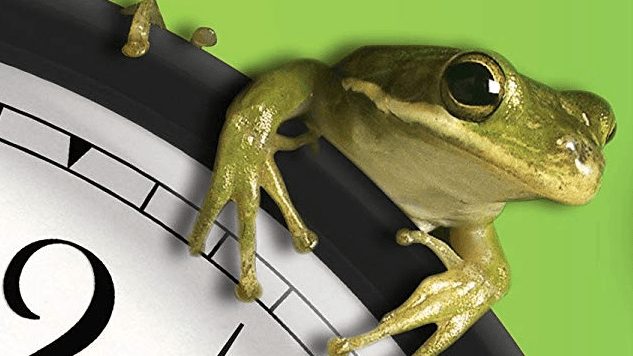
At some point in our lives, we all wonder if we’re using our time well—if we’ve “got our shit together.” Who among us hasn’t spent hours binge-watching Korean soap operas, eating jugs of rum chocolate and muttering to ourselves, “Yeah, I’m pretty sure this is what God wanted me to do with my time.”
But even for the fully-dedicated hedonist, a moment of reckoning comes. You realize the habits you learned as a child will not propel you in the adult world. The instant of clarity is different for everyone—maybe it’s in college, maybe it hits in your thirties, maybe when the first kid arrives. The time and place doesn’t matter; the moment is enough. And if this has already happened to you, congratulations! You’ve reached the next level of the maniac mansion known as Adulthood that we’re all faking.
The getting together of shit is essentially about organization and a thin tissue of clever tricks. That being said, how do you fool the world into believing you put your pants on two legs at a time?
The fact is, we can’t possibly diagnose what getting shit together would mean for you. Perhaps your problem is money; maybe it’s that ancient burial ground curse that’s followed you; maybe you just need to budget your time better. Perhaps you’re feeling out of control. Whatever it is, the books below apply to multiple circumstances. And while we can’t promise miracle remedies, these titles cover most of the ground of Getting Shit Together.
The Golden Rule of All Guides: If it works for you, it works, period.

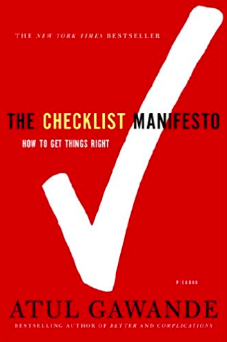 1. The Checklist Manifesto: How to Get Things Right by Atul Gawande
1. The Checklist Manifesto: How to Get Things Right by Atul Gawande
A surgeon, a doctor, a CEO, a writer—Atul Gawande does it all. Here he explains the secret behind the world’s most motivational to-do object: the humble checklist. There’s a lot of science in this little trick. Human minds have a limited real-time operating budget—about seven items long. Checklists are there to remind us to cross all the T’s and dot all the I’s. In fields like medicine and aeronautics, they are the difference between life and death in a world that seems deliberately built to punish human frailty.
But checklists do more than save lives; checklists lock in improvements. They make the byzantine business of precautions and best practices doable. The checklist takes an infinite series of choices, possibilities, warnings…and pushes them down to an easy set of reminders. What is improvement but a series of small, discrete and significant steps piled high? Day in, day out, we all strive to make our mark; a checklist merely shows us how.

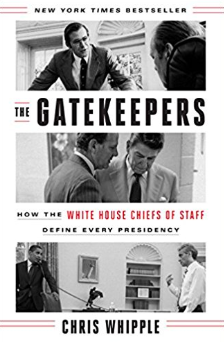 2. The Gatekeepers: How the White House Chiefs of Staff Define Every Presidency by Chris Whipple
2. The Gatekeepers: How the White House Chiefs of Staff Define Every Presidency by Chris Whipple
If you want to figure out how the kingdom is run, don’t look at the throne but at the woman or man standing next to it. The Gatekeepers is a short history of a long topic: power. More specifically, it details the characteristics, habits and useful pathologies of the people who have held the worst job in the world: White House Chief of Staff. The Chief is senior aide to the President, and does the job previously done by the President’s private secretary.
The Chief of Staff runs the Center Pivot of the Executive Branch of the United States. It’s a job beyond human endurance; no one can be Chief of Staff for long, but some have kept the race with a degree of ability. Their job is to enact the President’s agenda, to protect the White House and to speak truth to power. And these people are worth studying.
You might ask: why put a book about these strange, obsessed, Type-A people in a list about getting your act together? Consciously or not, most human beings learn from example. And there’s something to be learned from watching highly-able people go to work. If you’re curious what lies on the other side of having your shit together, these are the human beings Who Most Have It Arranged.

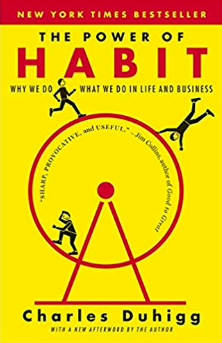 3. The Power of Habit: Why We Do What We Do in Life and Business by Charles Duhigg
3. The Power of Habit: Why We Do What We Do in Life and Business by Charles Duhigg
Achievement is not a matter of will; it’s a matter of habit. This is why the most successful people pick up habits, not build up their motivation. In his book, Charles Duhigg explains the habit cycle that underlines all repeated behavior: Cue, Routine, Reward, and Craving. Duhigg has a list of major and minor miracles worked via the power of habit.
Item 1: Duhigg tricked himself into stopping his chocolate-chip cookie habit.
Item 2: Duhigg tells a story about the depressed smoker, who went on a tour of Egypt and decided to come back and run across the desert sand. To do that, she had to change her habits—including what Duhigg calls a keystone habit. By changing one habit, she changed her entire life.
Item 3: the rise of Paul O’Neill, who as CEO of Alcoa applied the keystone habit of safety and made Alcoa massively profitable. It profits all of us to get in the groove of patterned behavior.
If you only read a single book on this list, make it this one.

 4. Getting Things Done: The Art of Stress-Free Productivity by David Allen
4. Getting Things Done: The Art of Stress-Free Productivity by David Allen
What comes after habit, goal-setting and discipline? How do you process the bewildering complexity of modern life? To do anything, you have to have a system.
There are thousands of methods. But most productivity warlocks and lifehack-hunters come back to worship at the altar of David Allen. There’s a reason for that—his system works.
Getting Things Done advocates can be unnecessarily worshipful of Allen’s doctrines, and there’s a weird branding ecosystem attached to GTD. But the system itself is fairly simple. You collect inputs: receipts, emails, articles you want to read, reminders, projects, notes, etc.. You process them, which amounts to making decisions about whether you want to do this action now, or defer it, or give it to someone else. Then you organize all of the projects you have. Then you plan ahead. And then you do them.
I scoffed at it—I laughed at the cult—and now I am a convert. Here’s the thing: even a watered-down, bastardized version of GTD works. But even if you don’t decide to internalize Allen’s setup, his design will show you what your own system should be like.

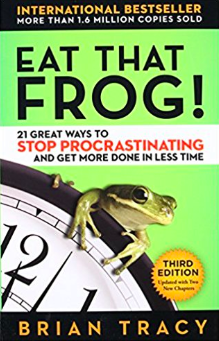 5. Eat That Frog! 21 Great Ways to Stop Procrastinating and Get More Done in Less Time by Brian Tracy
5. Eat That Frog! 21 Great Ways to Stop Procrastinating and Get More Done in Less Time by Brian Tracy
Mark Twain advised readers to start their day by getting their most dreaded task out of the way. If you have to eat a frog, he wrote, go ahead and get it over with. That’s Brian Tracy’s starting point, and he builds up steam from there.
In tone and in format, Tracy reads like an old-school bible of self-help. There’s an uncomplicated zeal for simple rules, but there’s also a lot of sharp tricks. Twenty-one pieces of advice, to be exact. Most of them are reiterations of a single dictum: stop procrastinating and do the thing you’re avoiding. Let me quote Tracy’s thesis, because you’re going to hear him restate it about five hundred times during the book, “Throughout my career, I have discovered and rediscovered a simple truth. The ability to concentrate single-mindedly on your most important task, to do it well and to finish it completely, is the key to great success, achievement, respect, status, and happiness in life.”
It’s the corniest delivery imaginable, but he’s right. If you only read two books in this list, make this the second.

 6. 18 Minutes: Find Your Focus, Master Distraction, and Get the Right Things Done by Peter Bregman
6. 18 Minutes: Find Your Focus, Master Distraction, and Get the Right Things Done by Peter Bregman
Peter Bregman and Brian Tracy sometimes get paired together in these kinds of lists. But where Tracy talks about action and results, Bregman’s approach is about being thoughtful.
Bregman asks the reader, “Why are you trying to be productive in the first place? What do you want? What’s the goal? Are you just trying to stay busy, or are you engaged in meaningful action?” The title 18 minutes refers to the suggested length of your daily review session, a habit Bregman argues for in this book. He states that productivity must have a centered, aware, self-reflective component; otherwise it’s mere busywork. You must know why you’re doing what you’re doing.
Above all, Bregman is in favor of taking a moment to find your compass.

 7. 168 Hours: You Have More Time Than You Think by Laura Vanderkam
7. 168 Hours: You Have More Time Than You Think by Laura Vanderkam
Did you know there are 168 hours in a week? Laura Vanderkam does. She’s made a career of analyzing the habits of the good, the great and the productive. Here, she takes a long look at the phenomenon of time—which, rumor has it, we all possess in the same amount. True, we don’t spend it the same way, but we draw from the same universal bank of hours.
After talking with dozens of impressive personages, Vanderkam tells us simple truths that (at some level) we probably already knew. Time management isn’t about finding little slices for important matters; it’s about keeping the important things important and making time for them first. Productive and proactive people actively select the best options.
Vanderkam returns to her proactive stance time and again. And this emphasis is crucial in the getting-your-shit-together game. We are what we do, which is a rephrasing of a far more dramatic truth: We are not what we do not do. In a world where doing is the common currency of achievement and growth, we must take our choices seriously.

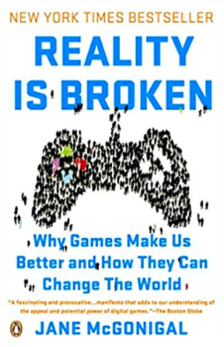 8. Reality Is Broken: Why Games Make Us Better and How They Can Change the World by Jane McGonigal
8. Reality Is Broken: Why Games Make Us Better and How They Can Change the World by Jane McGonigal
Life’s a game, and Jane McGonigal explains that game designers have reverse-engineered the neurology of human happiness. Hard work to level up in games is fun, she notes. But why?
McGonigal cites significant research done on the subject, including one player from the early days of Pong, who played the game with such reliable skill that he achieved a kind of Zen state. “When you strip away the genre differences and the technological complexities,” she writes, “all games share four defining traits: a goal, rules, a feedback system and voluntary participation.”
Therefore, McGonigal argues, we ought to gamify the world. Reality—the manufactured environment we spend our day-to-day lives in—is broken. And we must re-weave the rainbow. Through applying the lessons of gaming to real-life work, we can rediscover deep fulfillment and make even the most mundane moments into thrilling adventures. Even if you don’t game, consider this a worthwhile side quest. Play is as important as work when it comes to personal betterment.

 9. The Happiness Project: Or Why I Spent a Year Trying to Sing in the Morning, Clean My Closets, Fight Right, Read Aristotle, and Generally Have More Fun by Gretchen Rubin
9. The Happiness Project: Or Why I Spent a Year Trying to Sing in the Morning, Clean My Closets, Fight Right, Read Aristotle, and Generally Have More Fun by Gretchen Rubin
One day on the bus, Gretchen Rubin asked herself if she was happy. When she realized she hadn’t done much thinking or research on the issue, this book came out of that impulse. The Happiness Project is a no-bullshit colloquy on getting happy. Rubin has a down-to-earth, dry-eyed, factual way of finding out what works.
The secrets are, in no particular order: make other people happy, engage in purposeful efforts daily to be happy and write it all down.
Even when Rubin writes sentences that should be cliche—stuff like “soap and water removes most stains” or “outer order contributes to inner calm”—it doesn’t come across as banal lifestyle blogging. There are legit reasons for every rule she puts down. However, the big reason Rubin made this is a single sentence of a single chapter, a series of words that I have never forgotten:
What You Do Every Day Matters More Than What You Do Once In a While.
If you’ve already noticed that this goes hand-in-hand with habit-building, bravo. You are what you repeatedly do. So even when you’ve got the basics of every day worked out, come back to this book. It’s worth savoring.

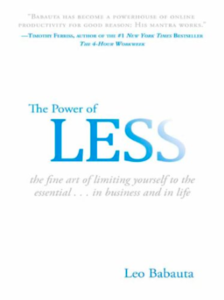 10. The Power of Less: The Fine Art of Limiting Yourself to the Essential…in Business and in Life by Leo Babauta
10. The Power of Less: The Fine Art of Limiting Yourself to the Essential…in Business and in Life by Leo Babauta
“Principle 1: By setting limitations, we must choose the essential. So in everything you do, learn to set limitations. Principle 2: By choosing the essential, we create great impact with minimal resources. Always choose the essential to maximize your time and energy.”
So writes Leo Babauta, the minimalist blogger. Life ought to be simple, but not too simple. You’re going to read a lot of books written by compulsively helpful and obsessively detailed people. But Babauta has done it all before. He realizes that willpower is a finite resource, and sometimes we just need a simple step-by-step, easy-commit process to change.
Getting better is largely about focus, and focus is about what you choose not to do. Babauta says we must figure out our goals, change our habits one at a time and roll on from there. Minimalism might not be for you, but you can learn the discipline of decision-making and how to focus on what really matters. Pick out the Most Important Tasks of your day—three or four of them—and proceed. It’s a quick study, too. After all, more Power of Less would be less power.

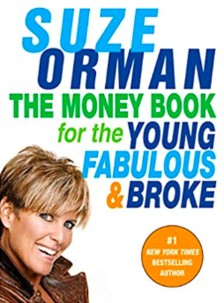 11. The Money Book for the Young, Fabulous & Broke by Suze Orman
11. The Money Book for the Young, Fabulous & Broke by Suze Orman
A lot of financial gurus are Boomers who assume the Old Economy still functions. But not Suze Orman, who is famous for reasonable and down-to-earth advice. She’s written a guide that’s sensitive to the youths, and it’s about time. So much of generational money-writing assumes that millennials are free spending on avocado-covered smartphones and don’t deal with or acknowledge the messed up economic situation.
But Orman levels with the reader and non-judgmentally shows the consumer how to break even. “Surviving on a small paycheck” and “Making the grade on student loans” are chapters here. Orman has a relatable, easygoing way of putting things: “Saving is for a short-term goal that you hope to reach within five years or so. Investing is for the long term.” If time is money, then this relatively short book saves plenty. What better endorsement can you get for a book about cash?

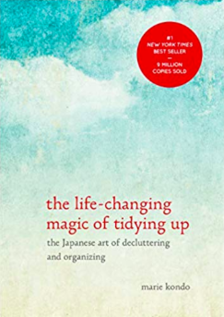 12. The Life-Changing Magic of Tidying Up: The Japanese Art of Decluttering and Organizing by Marie Kondo
12. The Life-Changing Magic of Tidying Up: The Japanese Art of Decluttering and Organizing by Marie Kondo
“The question of what you want to own is actually the question of how you want to live your life.”
Marie Kondo is for cleaning what Leo Babauta is for doing. In both cases, getting better is a matter of focusing, selecting and organizing. A decluttered house, room or apartment is physical, realized proof of your power to take command of your life. And in Kondo’s wildly popular book, she stresses the importance of choice, as objects we cling to represent “an attachment to the past or a fear for the future.”
A place for everything and everything in its place isn’t just a rule for the skillful use of a schedule, but the core principle of organizing. The owner of a space must decide if an object “sparks joy.” If it doesn’t, then out it goes. Freedom from want isn’t freedom, until we’re freed from what we don’t need as well.